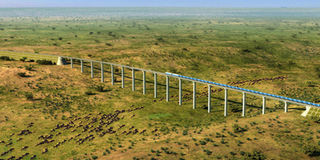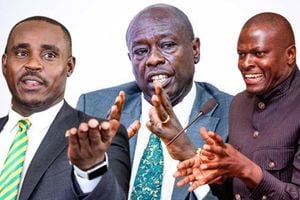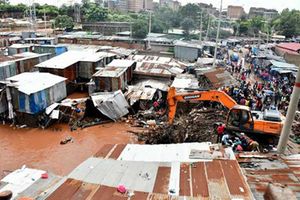East Africa scrambles for spoils of a limping, heaving Lunatic Express

What you need to know:
- According to the Africa Progress Report 2014, exorbitant transport costs and under-investment in infrastructure have been key barriers to intra-regional trade, but this can be overcome by regional cooperation on energy and transport to “achieve economies of scale in infrastructure projects”.
It is rare, when travelling from Mombasa to Uganda by road, to see a train trudging on the god-forsaken, narrow-gauge line that keeps popping up every often on the side.
But, should one get lucky at some point between Mombasa and Nairobi, or Nairobi and Kampala, one will see the Lunatic Express in its characteristically archaic and rusty demeanour, twirling across vales and plains like a massive millipede.
In the course of that journey, also, one is likely to get irritated by a fleet of long-distance trucks competing with passenger service and private vehicles plying the busy 1,700-kilometre highway that connects Kenya, from Mombasa, to Kigali in Rwanda through Nairobi and Kampala, Uganda.
On a lucky day, the journey takes about 20 hours from Mombasa to Kampala via Malaba by road, and an additional eight hours from Kampala onwards to Kigali.
But that is just a passenger on transit. With a high-speed and efficient passenger railway network, the transit time would be greatly cut down and comfort improved.
Many sections of the long stretch are also too rough and bumpy, thanks to the weight imposed on them by the multiple long-distance trucks. Even new roads are rendered less friendly by the trucks that have made permanent folds.
According to the Africa Progress Report 2014, exorbitant transport costs and under-investment in infrastructure have been key barriers to intra-regional trade, but this can be overcome by regional cooperation on energy and transport to “achieve economies of scale in infrastructure projects”.
The Lunatic Express, which is the current Kenya-Uganda train, was designed to ease the rather wearisome journey from Kenya’s coast to destinations across the country and in the East African region.
The purpose for its construction in the 1890s was to connect Kenya’s coast to the East African interior during the colonial era. Of particular interest was Uganda, on which the British wanted a stranglehold given its position as the source of River Nile.
With the rail track in place, the British would move soldiers quickly from the Kenyan coast to the hinterland, and onwards to the Great Lakes region to defend its empire against bitter colonial rivals, Germany and France.
British legislator Henry Labouchere’s denunciation of the plan by his government to build the Iron Snake would later give birth to its famous tagline; the Lunatic Express. He questioned the logic of constructing the rail network, arguing: “Where it is going, nobody knows. What is the use of it; none can conjecture. It is clearly nought but a lunatic line.”
Today, nearly 100 years since Indian coolies laid the last piece of iron on the lunatic track, it has grown a bit obsolete as passenger and cargo schedules are rarely met.
Cows, goats and sheep, taking advantage of the little traffic on this line, have the luxury of resting on some isolated parts of the track, relishing in the safety of a rundown network that has failed countless attempts to keep it spick and span. Some parts have been overgrown by grass, while yet many others lie beneath mounds of dirt.
That is why analysts forecast that the signing of financing deal between China and Kenya on May 11 this year to build a new Standard Gauge Rail (SGR) theoretically marked the end of the road for the Lunatic Express.
The China Road and Bridge Corporation (CRBC) will undertake the construction of the SGR, which will accommodate some 1,620 freight wagons, 59 locomotives and 40 passenger coaches that are to form part of the new rail network.
The freight trains will have a speed ceiling of 80 kilometres per hour while passenger trains will be limited at 120 kilometres per hour.
The Chinese contractors have been fighting accusations that they were single-sourced for the work, and that the cost was inflated, but, despite the finger-pointing, China, which is planning to build an ambitious 13,000-kilometre rail to connect bullet trains to the US via Russia, is expected by many to deliver on the promise of a new rail network for East Africa, given the Asian giant’s record of having the largest rail network in the world.
Faster transportation
Mr Kassim Omar, chairman of the Uganda Clearing Industry and Forwarding Association, argues that the SGR would facilitate wider and faster transportation of cargo and labour in the entire region. He, however, cautions that the new rail will not be a silver bullet to solving the cost of products.
Before the elimination of most forms of non-tariff barriers like roadblocks, it used to take at least 18 days for a truck to transport goods from Mombasa to Kampala and back; now it takes about seven days.
That time could still be cut down to four through the SGR, according to Mr Omar, who also doubles up as a director at the East African Business Council (EABC).
“The issue of efficiency in the transportation process is very important. As long as cargo is moved efficiently on the new rail, the possibility is that time will be reduced to four or five days from Mombasa to Kampala and back.”
Kenya’s Transport ministry has often condemned the Rift Valley Railways (RVR), which holds a 25-year concession to manage the freight business and maintain the Lunatic Express, over underperformance.
The concessionaire’s passenger deal was cut to one year from five and its future is now threatened by the new network. An earlier 25-year concession that was to be handed over to South Africa’s Sheltam Rail Company in 2006 never took off, further derailing plans to resuscitate the cash-draining service.
The 2014 Economic Survey released by the Kenya National Bureau of Statistics (KNBS) indicates that the railway transport sub-sector was in 2013 characterised by declines in both freight and passenger streams.
“The declines were partly attributed to poor rail infrastructure and aging equipment which incur high maintenance costs and occasionally result in derailments,” the Economic Survey indicated.
Speaking of the SGR project, the Kenya Railways MD Atanas Maina, said his team was “under no illusions as to the enormity of the task ahead” since this project “is unmatched in the history of Kenya in terms of scope and cost”.
The 609 kilometres of a single-track line from Mombasa to Nairobi will be built first as part of a regional tri-partite project connecting Kenya, Uganda, Rwanda and South Sudan. The second phase will involve the construction of the line from Nairobi to Malaba, a border town, with another line branching to Kisumu.
The final plan is to connect the SGR from Mombasa to Kigali, through Kampala and onwards to Juba. The entire East African project could cost in excess of Sh1.2 trillion.
Coupled with the reduction of various forms of non-tariff barriers like a number of weighbridges and roadblocks in the Northern Transport Corridor that connects Kenya, Uganda and Rwanda, the new line is expected to enhance trade deals and cut down the cost of doing business in the East African region, which has about 140 million people.
For Mr Adalbert Hamisi, a truck driver from Rwanda, the SGR will boost the economies of East African countries, making trade across borders almost seamless.
It takes him at most seven days to transport goods from Mombasa to Kigali by road. But under the new system the transportation of goods will be much faster, even though it will have to correspond with the full operation of the One-Stop Border Posts (OSBPs) that are being constructed at various border points within the East African Community (EAC).
Currently, the goods cleared from one country are also cleared on the other side of the neighbouring country, reducing the turnaround time. But the OSBPs will allow clearance of goods in single customs territory at border points and this should add to the efficiency the new high-speed train is set to bring.
“The problem now is the slow clearance at the border points,” Mr Hamisi said in an interview at the Malaba border.
But East Africa could just have grasped a chance for another renaissance with presidents Uhuru Kenyatta of Kenya, Yoweri Museveni of Uganda, Paul Kagame of Rwanda and Salva Kiir of South Sudan standing by the Chinese Prime Minister Li Keqiang as he signed the financing agreement for the SGR.
President Kenyatta is optimistic that the new line would “sharply” bring down the cost of transporting people and goods across the region. The indication was that the cost of transporting one tonne of cargo would fall from 20 US cents per kilometre to eight US cents over the same distance.
China’s goodies are not coming on a silver platter though, according to analysts. The most populous and second largest economy in the world continues to develop colossal appetite for Africa’s raw materials and minerals like oil to feed a ballooning demand back home. The country is also out to look for markets in Africa for its finished products.
To cement its interest on the African continent, China has increased its funding of infrastructure projects on the continent and promises multi-billion-dollar, no-political-strings-attached financing deals.
The new line will leave an indelible mark on the economies of participating countries. Kenya’s part will cost Sh327 billion ($3.8 billion) and construction work will kick off in August this year. But Nairobi will have to pay back at least Sh500 billion ($5.7 billion) to clear the loan. Uganda, which is Kenya’s biggest trading partner, plans to tap private sector funds to bankroll its side of the SGR.
During the Africa Investor CEO infrastructure investment summit in Abuja, Nigeria on May 6, African leaders stressed the need to invest in regional and cross-border infrastructure deals jointly as such investments have the potential to greatly boost trade, improve security, strengthen the management of natural resources, and unlock the potential of landlocked countries while leveraging on national and regional comparative advantages.
“In the East African Community, deliberate priority is given to the development of key regional transport corridors that in turn support trade and investment,” President Kenyatta, who is also the current chairman of the EAC, said during the summit.
“An important aspect of our infrastructure development is the need for a regional approach. Economies of scale from regional infrastructure often cut the costs of construction and services.”
Paul Collier, an Economics Professor, in a publication for the International Monetary Fund (IMF) in 2011, noted that new transportation infrastructure like railways are vital to harness potential sources of growth on the continent.
Open up vast tracts

“By radically reducing transportation costs, railways could open up vast tracts of Africa to economic opportunities, especially in agriculture and mining, which many countries are relying on for future growth,” Prof Collier wrote.
According to the African Development Bank, most of the only significant international network is centred in South Africa and stretches north to Zimbabwe, Zambia and the DRC. South Africa, the only country in Africa with a good rail network, revamped the system and introduced an underground commuter train between Johannesburg and Pretoria before the FIFA World Cup in 2010.
On its part, Tanzania, which is not part of the SGR, has embarked on a Sh28.7 billion ($330 million) revamping of the Central Transport Corridor connecting Dar-es-Salaam with Burundi, Rwanda and the DRC. This line is expected to haul over 30 million tonnes of freight each year to the region.
On the other hand, the SGR, which is expected to be operational by 2018, is expected to transmit at least 28 million tonnes of cargo each year between Kenya, Uganda and Rwanda.




